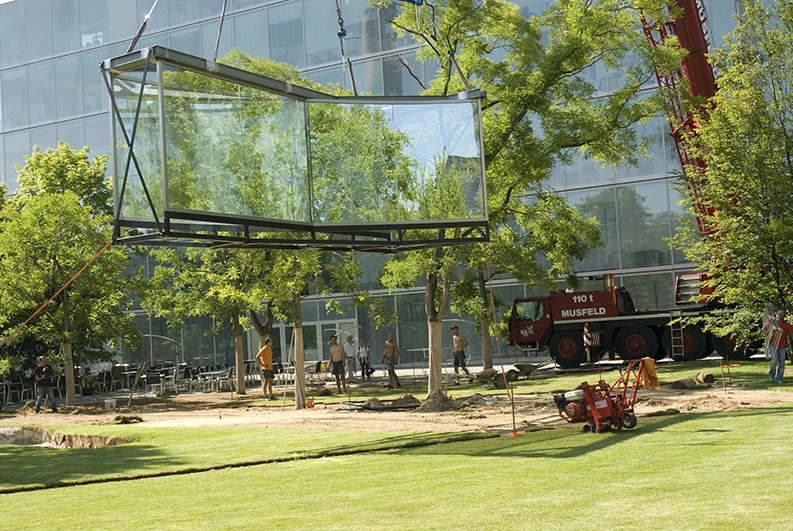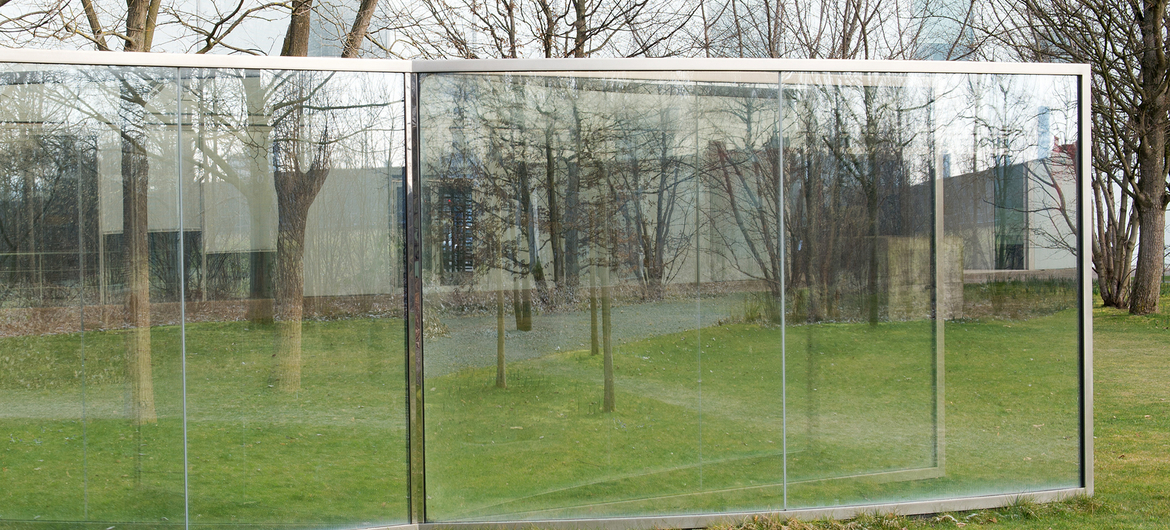Year: 2007-2008
Material/Technique: Two-Way Mirror Glass and Steel
The Two-way Mirror Pavilion Curve and Straight Line is precisely tailored to the Novartis south park and is placed in a carefully calculated position on the lawn in front of the SANAA building. The floor plan is roughly in the shape of the letter X, with one line arched and the other straight. The pavilion consists of two glass walls, mirrored on both sides, one of which is set slightly concave to the building and the other straight. These intersecting walls are framed in steel. The mirror glass itself is semi-transparent, allowing a through view.
The structures invite a dialogue between spectator and landscape, artwork and art context, and raise questions about the uses and effects of sites designated as public.
In Graham-s words: “My pavilions in two-way mirror glass mimic the condition of architecture in the city. They simultaneously evoke the historical precedent of garden pavilion forms from the Renaissance and rococo fabriques in Western garden-art to Chinese garden pavilions, which used circular open portals and windows. Renaissance pavilions were often quasi-educational as well as entertaining experiences.
My pavilions are to be experienced from both the inside and outside. Depending on the lighting conditions at a given moment, they can be mirrorized on the outside, and thus conceal the existence of interior viewers or equally transparent and reflective simultaneously from inside and outside. They demonstrate to the viewers their own bodies and themselves as perceiving subjects - and also allow them to see other spectators perceiving themselves. The relation of inside to outside, because of the perceptual properties of the materials constituting the pavilion, is in constant flux, dependent upon clouds, sun and environmental features. These alterations in turn effect the perceptions of the viewers, their perceptions of themselves, of other spectators, of the landscape, the material/structure of pavilion.”
Artist
Dan Graham is an American artist and curator best known for his integral role in beginnings of Conceptual Art during the 1960s. His provocative art and theories analyze the historical, social and ideological functions of contemporary cultural systems, including architecture, rock music, and television. In performances, installations, and architectural/sculptural designs, he investigates public and private, audience and performer, objectivity and subjectivity. Deconstructing the phenomenology of viewing, he manipulates perception with time delay, projections, closed- circuit video, and mirrors.
He was raised in New Jersey, though he never attended college he educated himself in anthropology, French literature, and other subjects. His time as a music critic for magazines, especially rock music, led Graham to produce works that embody a spirit of rebellion. Graham currently lives and works in New York, NY. Today, his works are held in the collections of the Art Institute of Chicago, The Museum of Modern Art in New York, the Tate Gallery in London, the Los Angeles County Museum of Art, and the Walker Art Center in Minneapolis, among others.
His critical engagement manifests most notably in the glass and mirrored pavilions, which have been realised since the late 1970s, in sites all over the world. Sharply geometrical in design, composed of transparent or mirrored glass, and placed in public spaces, the pavilions continue the investigation into public and private space that has marked Graham's work since his earliest magazine pieces and performances.
These works investigate the complex relationship between the art object and its viewer, providing a cross section of the diversity of his practice and highlighting the artist’s unique interaction with his audience through his projects. Graham’s pavilions are created on a human scale; the two-way mirrored glass allowed viewers watching the film to see themselves as they are invited to lounge on the floor, whilst visitors standing outside of the structure can observe the people lounging inside, implicating the spectator as part of the structure and reversing the roles of subject and object.

